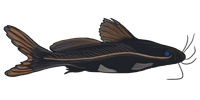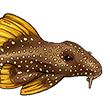new synodontis
-
FatCat
- Posts: 87
- Joined: 02 May 2003, 01:10
- Location 1: Kansas USA
- Interests: Fish, Wildlife, Computers, Music
new synodontis
Sorry no digital cam in the budget yet but have some good clues to go by. Also not totally fimaliar with the lingo for the body part description so maby you could correct me so i can learn what the parts are called also. Picked up a syno today great deal couldnt pass it up for these fish in my area, however im not totally sure of its identity. it was labeled lace cat (common for S Nigrita). there were 2 in the tank that fit the nigrita perfectly light color with small dark spots body shape matches up as well. The rest in the tank were slightly different although the body types were mostly identical the coloration was alot darker with the spotting being much more random and larger spots. It also has 2 pale striped areas similar to the pics in the E log of the S Greshoffi. Is this pale striping areas common in juvenile synos? Also I can not see the pronounced triangular bony structures behind the skull (what are those called?) that is seen clearly in the nigritas at the LFS. Its color patern looks like the Greshoffi but darker and minus the pronounced bony skull structure. Ive noticed that it is noticable in some species yet not in others, is this just a skin tone issue that just hides the feature that is present in all Synos? Hopefully this is sufficient information for some kind of a lead. Also I think it would be nice to have a page in the site with a diagram listing the correct terms for different body parts of the fish so guys like me that dont know all the proper lingo for every part of the fish can refrence and hold on an intelligent conversation without sounding like fools 
- Silurus
- Posts: 12468
- Joined: 31 Dec 2002, 11:35
- I've donated: $12.00!
- My articles: 55
- My images: 902
- My catfish: 1
- My cats species list: 90 (i:1, k:0)
- Spotted: 432
- Location 1: Singapore
- Location 2: Moderator Emeritus
If by pale striped areas you mean those on the body, thgen yes, that is a feature more readily apparent on juveniles. The traingular structure behind the head you refer to is the humeral (or cleithral) process. It's a key feature used to distinguish <i>Synodontis</i> species as its shape can vary quite a bit among them.
It's very hard to identify spotted synos without a picture. It's possible that yopu might just have <i>S. nigrita</i>, since there can be quite a fair bit of variation in color, but it's really hard to tell without a picture.
It's very hard to identify spotted synos without a picture. It's possible that yopu might just have <i>S. nigrita</i>, since there can be quite a fair bit of variation in color, but it's really hard to tell without a picture.





